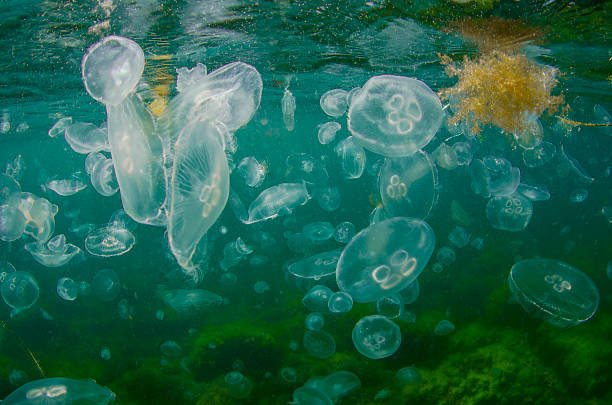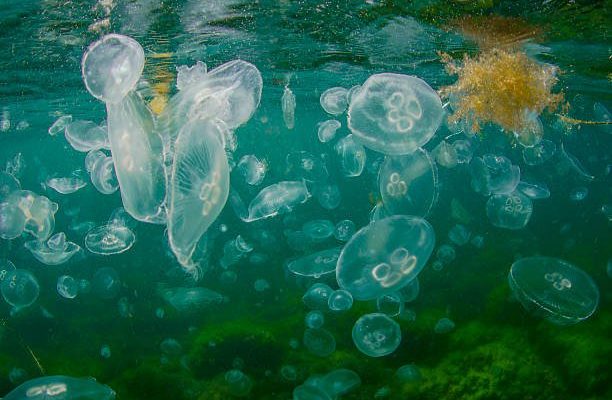
Moon jellyfish, or *Aurelia aurita*, are remarkably adaptable. Their bodies are 95% water, and they have a unique way of navigating through the sea that resembles a soft, pulsing dance. Imagine being able to drift along the currents without a care in the world! But their beauty hides a fascinating story of survival and adaptability. So, where can you find these stunning creatures? Let’s explore the various environments where they thrive.
Oceans: The Jellyfish’s Primary Home
When we picture jellyfish, our minds often drift to the ocean. Moon jellyfish are primarily found in coastal waters around the world. They prefer warm waters, usually living in shallow areas of the sea. From the Mediterranean Sea to the waters of the Pacific and Atlantic Oceans, you’ll find them drifting along the coasts.
You might be surprised to learn that moon jellyfish are often found in areas with high nutrient levels. These nutrient-rich waters provide a buffet of food options for jellyfish, primarily small fish and plankton. In some regions, they can even be seen in large swarms, creating a beautiful spectacle that can be both enchanting and slightly eerie. Imagine standing on a pier and seeing a shimmering mass of jellyfish beneath the surface!
Coastal Habitats
Coastal habitats, like bays and estuaries, are especially favorable for moon jellyfish. They thrive in areas with calm waters that are less turbulent, allowing them to float freely and absorb sunlight. These environments are often teeming with life, making them a perfect home for moon jellyfish. This is especially true during the summer months when water temperatures rise, providing a warm haven for these fascinating creatures.
Additionally, moon jellyfish are known to tolerate a range of salinity levels. This adaptability allows them to flourish in various coastal settings, from brackish waters of estuaries to the open sea. It’s like having a versatile living room that can fit into any corner of your home!
Bays and Estuaries: The Transition Zones
Bays and estuaries serve as a blend of land and sea, offering unique habitats for moon jellyfish. These areas are often calm and provide plenty of food. You can think of them as jellyfish restaurants, where the menu is full of tasty plankton and small fish. Many people don’t realize that moon jellyfish can tolerate lower salinity levels, which is common in estuaries.
During certain times of the year, you might spot an increase in their population as they swarm into these sheltered waters. In fact, some researchers have documented their life cycles in these habitats, showing how they can thrive in varying conditions. Their ability to adapt to both salt and fresh waters showcases their impressive resilience. Honestly, it’s like they have a built-in GPS for finding the best buffet!
Rivers: An Unexpected Habitat
While it might sound surprising, moon jellyfish can be found in rivers as well. They are known to travel up freshwater rivers, especially when conditions are right. This occurs more commonly during heavy rainfalls or floods, which can flush saltwater into rivers, creating a more favorable environment for these jellyfish.
As jellyfish navigate upstream, they can often be spotted in areas where rivers meet the sea, known as estuaries. This is a crucial transition zone for many marine species, including moon jellyfish, which can thrive in these mixtures of salt and fresh water. Imagine taking a stroll alongside a river and spotting a jellyfish bobbing along the current—it’s a unique experience that highlights their adaptability.
The Journey of the Moon Jellyfish
The journey of a moon jellyfish is fascinating. They can drift hundreds of miles across the ocean or venture into rivers, all in search of food and suitable habitats. Some studies suggest that moon jellyfish can even survive in less-than-ideal conditions by entering a state of dormancy until they can return to more favorable waters. This tenacity is truly remarkable!
Environmental Factors Influencing Distribution
Understanding where moon jellyfish thrive involves looking at environmental factors. Water temperature, salinity, and nutrient availability all play crucial roles in their distribution. For example, warming ocean temperatures due to climate change have been associated with increased jellyfish populations.
More nutrients in the water, often from runoff or overfishing, can lead to blooms of moon jellyfish. They essentially capitalize on the abundance of food, leading to those stunning swarms we sometimes see. You might be wondering how this affects the marine ecosystem. Increased jellyfish populations can disrupt local marine life, creating challenges for fish and other aquatic animals.
Global Presence of Moon Jellyfish
Moon jellyfish aren’t confined to one specific region; they have a global presence. From the coastlines of North America to the shores of Europe and Asia, they make their homes in various oceans around the world. This wide distribution can be attributed to their ability to adapt to different environmental conditions, making them a resilient species.
You’ll find them in popular beach destinations, where tourists often encounter their beauty while swimming or snorkeling. In some regions, moon jellyfish have become a part of local culture, symbolizing the beauty and mystery of the ocean. They remind us of the intricate balance of marine ecosystems, illustrating how even the smallest creatures have their role to play.
Moon Jellyfish and Human Interaction
Moon jellyfish have a unique relationship with humans. While they are mostly harmless, their presence can sometimes impact local fishing industries and tourism. Of course, seeing them can be a breathtaking experience, but it’s essential for swimmers to be cautious. Understanding their habitats helps us appreciate and coexist with these remarkable creatures.
Moon jellyfish are enchanting creatures that inhabit a range of environments, from the open ocean to coastal bays and even rivers. Their adaptability and resilience make them fascinating subjects of study and a beautiful sight for beachgoers. By learning about where they thrive, we gain insight into the health of our oceans and waterways, reminding us of the interconnectedness of all life.
So, the next time you find yourself at the beach, keep an eye out for those delicate moon jellyfish floating by. They’re not just beautiful; they’re part of a complex and dynamic ecosystem. Here’s the thing: knowing where they live helps us appreciate their role in our world even more. Whether it’s the ocean’s open expanse or the calm of a local river, moon jellyfish remind us that beauty often resides in the most unexpected places.

